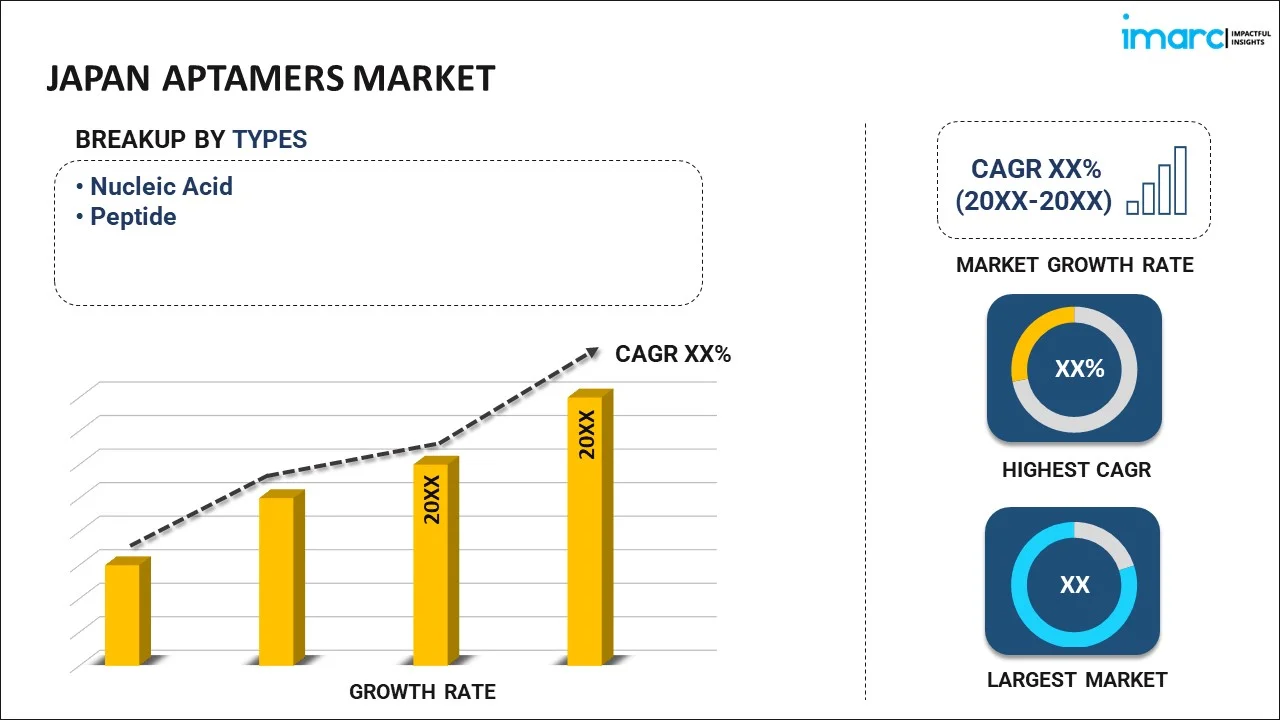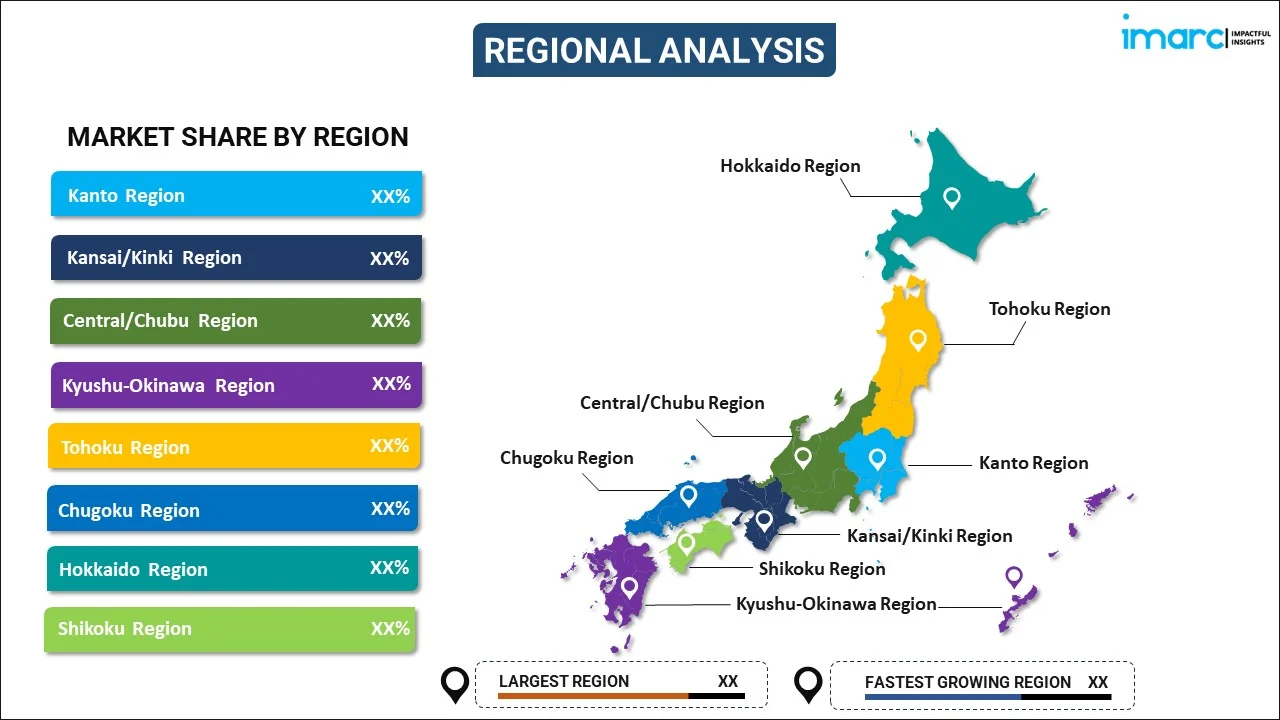
Japan Aptamers Market Report by Type (Nucleic Acid, Peptide), Application (Diagnostics, Therapeutics, Research and Developments, and Others), and Region 2025-2033
Market Overview:
Japan aptamers market size reached USD 183.0 Million in 2024. Looking forward, IMARC Group expects the market to reach USD 634.0 Million by 2033, exhibiting a growth rate (CAGR) of 14.80% during 2025-2033. The rising demand for innovative diagnostic and therapeutic solutions, increasing utilization in detecting biomarkers, and the growing integration into cutting-edge drug delivery systems represent some of the key factors driving the market.
|
Report Attribute
|
Key Statistics
|
|---|---|
|
Base Year
|
2024 |
|
Forecast Years
|
2025-2033
|
|
Historical Years
|
2019-2024
|
| Market Size in 2024 | USD 183.0 Million |
| Market Forecast in 2033 | USD 634.0 Million |
| Market Growth Rate (2025-2033) | 14.80% |
Aptamers, also known as chemical antibodies, are short, single-stranded deoxyribonucleic acid (DNA) or ribonucleic acid (RNA) molecules that can selectively bind to specific target molecules, such as proteins, small molecules, and whole cells. They are artificially synthesized through the systematic evolution of ligands by exponential enrichment process. They are stable under a wide range of conditions, including extreme temperatures and pH levels, and contribute to their utility in diverse environments. They can be chemically synthesized with high purity, allowing for cost-effective production and customization. They generally have low immunogenicity, which reduces the likelihood of immune responses when used in biological applications. They provide precise targeting of specific molecules, enabling researchers to study and manipulate biological processes with optimal accuracy. They are widely used in diagnostic assays for detecting biomarkers associated with diseases, making them invaluable for early disease detection. Besides this, they find numerous applications in environmental monitoring to detect pollutants and contaminants.
Japan Aptamers Market Trends:
The escalating demand for innovative diagnostic and therapeutic solutions in Japan represents one of the key factors favoring the market growth. Additionally, the increasing utilization of aptamers in detecting biomarkers associated with diseases like cancer and infectious diseases is strengthening the growth of the market. Along with this, the presence of a robust pharmaceutical and biotechnology sector in Japan is contributing to the market growth. Apart from this, the integration of aptamers into cutting-edge drug delivery systems is supporting the market growth. Moreover, rising collaborations between academic institutions, biotech firms, and pharmaceutical giants are driving research and development (R&D) activities to harness the therapeutic potential of aptamers, further bolstering the market growth. Besides this, the regulatory support and streamlined approval processes for innovative biotechnological products is offering a favorable market outlook. Furthermore, the regulatory authorities in the country are actively working to facilitate the development and commercialization of biopharmaceuticals, including aptamer-based drugs. Besides this, the ongoing research into novel aptamer modifications and delivery mechanisms is positively influencing the market. Researchers are continually improving the stability, specificity, and pharmacokinetics of aptamers, making them even more effective as therapeutic and diagnostic tools. Additionally, Japan is witnessing a rise in the development of aptamer-based point-of-care (POC) diagnostic devices. These user-friendly, rapid-testing platforms leverage the specificity of aptamers to detect biomarkers or pathogens in clinical settings. Moreover, the expanding aging population in the country, which is highly susceptible to several chronic diseases, is facilitating the market growth. Leading universities and research institutions in Japan are actively engaged in aptamer-related studies, fostering a culture of innovation and knowledge exchange. This academic prowess contributes to the development of novel aptamers.
Japan Aptamers Market Segmentation:
IMARC Group provides an analysis of the key trends in each segment of the market, along with forecasts at the country level for 2025-2033. Our report has categorized the market based on type and application.
Type Insights:

- Nucleic Acid
- Peptide
The report has provided a detailed breakup and analysis of the market based on the type. This includes nucleic acid and peptide.
Application Insights:
- Diagnostics
- Therapeutics
- Research and Developments
- Others
A detailed breakup and analysis of the market based on the application have also been provided in the report. This includes diagnostics, therapeutics, research and developments, and others.
Regional Insights:

- Kanto Region
- Kansai/Kinki Region
- Central/ Chubu Region
- Kyushu-Okinawa Region
- Tohoku Region
- Chugoku Region
- Hokkaido Region
- Shikoku Region
The report has also provided a comprehensive analysis of all the major regional markets, which include Kanto Region, Kansai/Kinki Region, Central/ Chubu Region, Kyushu-Okinawa Region, Tohoku Region, Chugoku Region, Hokkaido Region, and Shikoku Region.
Competitive Landscape:
The market research report has also provided a comprehensive analysis of the competitive landscape. Competitive analysis such as market structure, key player positioning, top winning strategies, competitive dashboard, and company evaluation quadrant has been covered in the report. Also, detailed profiles of all major companies have been provided.
Japan Aptamers Market Report Coverage:
| Report Features | Details |
|---|---|
| Base Year of the Analysis | 2024 |
| Historical Period | 2019-2024 |
| Forecast Period | 2025-2033 |
| Units | Million USD |
| Scope of the Report | Exploration of Historical and Forecast Trends, Industry Catalysts and Challenges, Segment-Wise Historical and Predictive Market Assessment:
|
| Types Covered | Nucleic Acid, Peptide |
| Applications Covered | Diagnostics, Therapeutics, Research and Developments, Others |
| Regions Covered | Kanto Region, Kansai/Kinki Region, Central/ Chubu Region, Kyushu-Okinawa Region, Tohoku Region, Chugoku Region, Hokkaido Region, Shikoku Region |
| Customization Scope | 10% Free Customization |
| Post-Sale Analyst Support | 10-12 Weeks |
| Delivery Format | PDF and Excel through Email (We can also provide the editable version of the report in PPT/Word format on special request) |
Key Questions Answered in This Report:
- How has the Japan aptamers market performed so far and how will it perform in the coming years?
- What has been the impact of COVID-19 on the Japan aptamers market?
- What is the breakup of the Japan aptamers market on the basis of type?
- What is the breakup of the Japan aptamers market on the basis of application?
- What are the various stages in the value chain of the Japan aptamers market?
- What are the key driving factors and challenges in the Japan aptamers?
- What is the structure of the Japan aptamers market and who are the key players?
- What is the degree of competition in the Japan aptamers market?
Key Benefits for Stakeholders:
- IMARC’s industry report offers a comprehensive quantitative analysis of various market segments, historical and current market trends, market forecasts, and dynamics of the Japan aptamers market from 2019-2033.
- The research report provides the latest information on the market drivers, challenges, and opportunities in the Japan aptamers market.
- Porter's five forces analysis assist stakeholders in assessing the impact of new entrants, competitive rivalry, supplier power, buyer power, and the threat of substitution. It helps stakeholders to analyze the level of competition within the Japan aptamers industry and its attractiveness.
- Competitive landscape allows stakeholders to understand their competitive environment and provides an insight into the current positions of key players in the market.
Need more help?
- Speak to our experienced analysts for insights on the current market scenarios.
- Include additional segments and countries to customize the report as per your requirement.
- Gain an unparalleled competitive advantage in your domain by understanding how to utilize the report and positively impacting your operations and revenue.
- For further assistance, please connect with our analysts.
 Inquire Before Buying
Inquire Before Buying
 Speak to an Analyst
Speak to an Analyst
 Request Brochure
Request Brochure
 Request Customization
Request Customization




.webp)




.webp)












